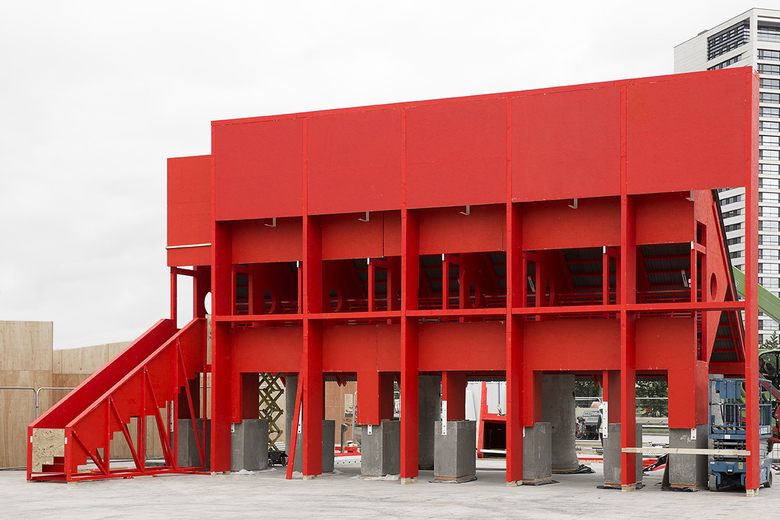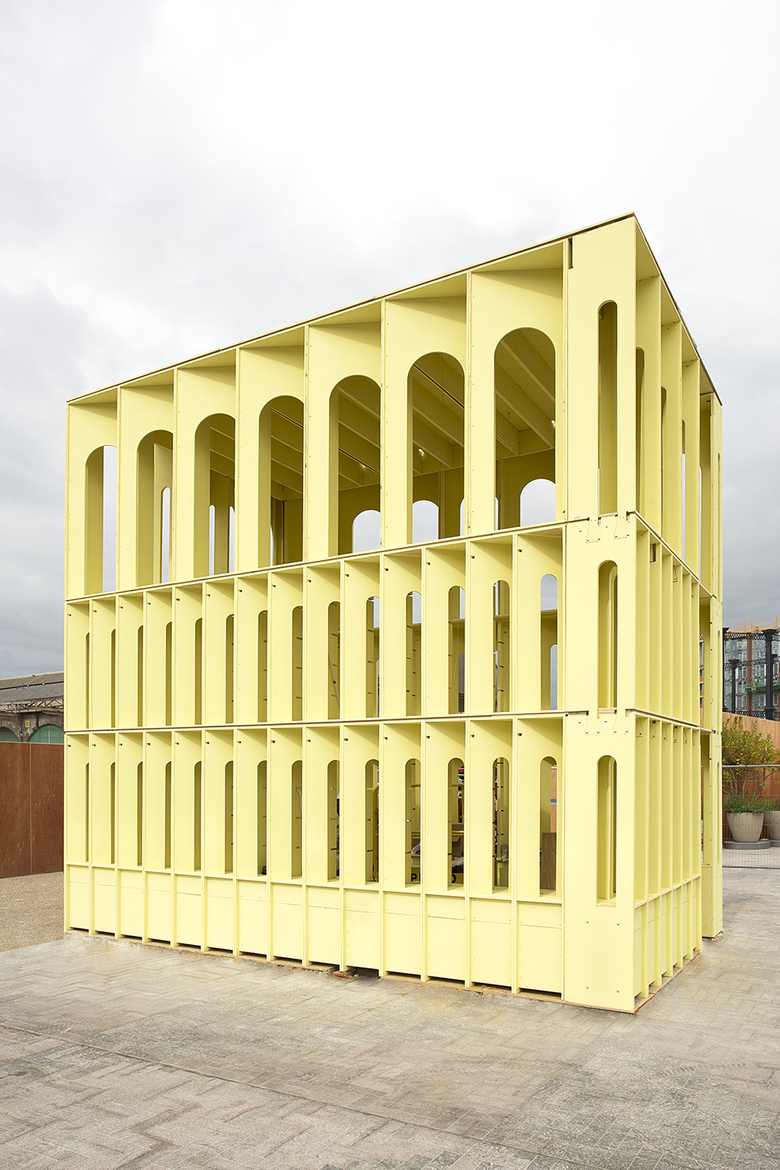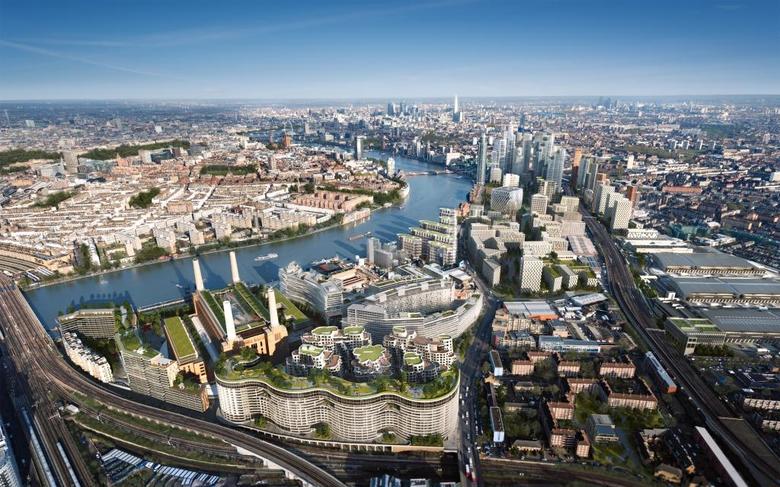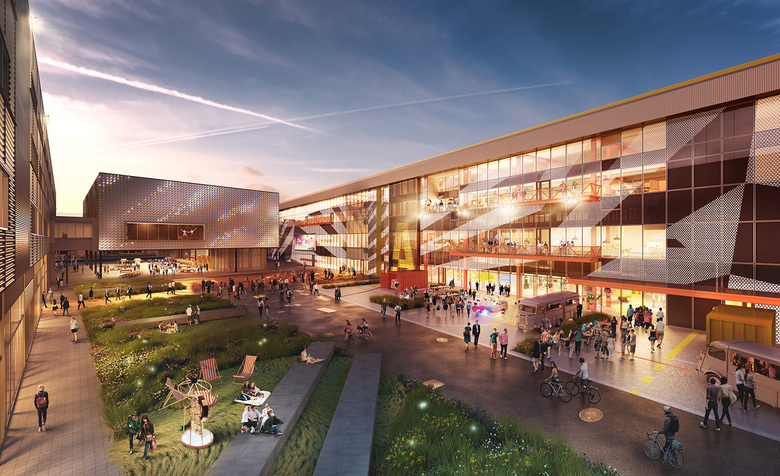A Short Guide to the LFA
John Hill
8. June 2015
Red Pavilion by TAKA, Clancy Moore and Steve Larkin in King’s Cross, as part of ID2015’s New Horizon_architecture from Ireland, for London Festival of Architecture 2015 (Photo: © Ed Reeve)
The London Festival of Architecture takes place throughout the month of June under the theme Work in Progress. We highlight ten of the installations, exhibitions, and events happening as part of the LFA.
The organizers of the London Festival of Architecture 2015 see the Work in Progress theme as a means of exploring "the changing nature of work, and workspace, but also its impact on, and role in, the evolution of London." As industry in the city has shifted to financial services, "matched by its position as a global leader for the creative industries," the LFA is "starting to expand the festival’s international reach, to celebrate, and amplify, the creative and technical talent that resides in our city." This is happening through over 240 talks, exhibitions, tours and installations, but they are accompanied by the festival's very first Focus Country: Ireland.
Red Pavilion by TAKA, Clancy Moore and Steve Larkin in King’s Cross, as part of ID2015’s New Horizon_architecture from Ireland, for London Festival of Architecture 2015
Ireland's selection as Focus Country coincides with Irish Design 2015, a yearlong international celebration of Irish design through events and activities in Ireland and abroad. The first iteration of the three-part New Horizon_architecture from Ireland is taking place at the LFA. The project is made up of a series of presentations on the work of emerging Irish architecture practices, selected by curators Raymund Ryan and Nathalie Weadick. For the LFA, ID2015 has installed two temporary pavilions at Lewis Cubitt Square, a new public space at King's Cross. The Red Pavilion, located at the square's northern end, was designed by three young practices from Dublin: TAKA Architects, Clancy Moore Architects, and Steven Larkin Architects. Recalling Bernard Tschumi's bright-red folies at Parc de la Villette in Paris, the Red Pavilion is open, featuring a walkway beneath a large roof.
Yellow Pavilion by Hall McKnight Architects in King’s Cross, as part of ID2015’s New Horizon_architecture from Ireland, for the London Festival of Architecture 2015 (Photo: ©Ed Reeve)
Located at the southwest corner of the square is the more enclosed Yellow Pavilion, designed by Hall McKnight Architects. The pavilion design responds to the LFA's Work in Progress theme by housing an exhibition of 1,000 reclaimed bricks from Belfast, where the firm is located. According to the architects, "The Yellow Pavilion is manufactured from a kit of pieces cut from boards and assembled in units. The pavilion contains an installation that is an allegory of the city as an open project – alive, ongoing. The pavilion is a vehicle to a collection of bricks that speaks of a city as a work in progress."
All four Irish architects will take part in New Now Next, a panel discussion curated by the Irish Architecture Foundation, sponsored by Arup and hosted at the Design Museum on 17 June.
Yellow Pavilion by Hall McKnight Architects in King’s Cross, as part of ID2015’s New Horizon_architecture from Ireland, for the London Festival of Architecture 2015 (Photo: © Ed Reeve)
New London Architecture (NLA), "an independent forum for discussion, debate and information about architecture, planning, development and construction in the capital," heads out into the city streets for the installation Never Mind the Bollards, curated by public realm expert Sarah Gaventa. Referencing the famous album Never Mind the Bollocks, Here's the Sex Pistols, the installation uses the surface of Store Street South Crescent (outside NLA's Building Centre and not far from the British Museum) to explore "the social design history and meaning of elements in our public spaces we walk by and over everyday – what do they do? Who designed them and when/why?" The installation is on display until 11 July.
Never Mind the Bollards, New London Architecture (Photo: Paul Raftery/bdonline)
NLA turned 10 in 2015, and to celebrate this milestone it is holding the exhibition Public London: 10 years of transforming spaces at the Building Centre until 11 July. Public London "look[s] back over the decade, celebrating the best projects and initiatives and looking at the drivers behind our changing attitudes, including ... the impact of major infrastructure projects, cycling initiatives, government-led investments and regeneration programs, temporary spaces and community-led initiatives." Falling under the last is Thames Baths, "a social enterprise established by Studio Octopi for the re-introduction of swimming in urban waterways, notably the River Thames. The proposals look to re-establish an intimate and playful link between Londoners and this historic lifeblood of the city."
New London Architecture, 'Public London, Ten Years of Transforming Spaces' Thames Baths (Image: © StudioOctopi & Picture Plane)
Giant Dolls House Project – SHOEBOX for SHELTER, a project by Catja de Haas and Lala Thorpe, is on display at Shelter Cafe until 10 June. It is part of their ongoing collaborative arts project that engages local communities and raises funds for the homeless charity Shelter. Participants are asked to make an individual dolls' house-room out of an empty shoebox. The completed boxes are then assembled on a black canvas and connected to each other through ladders and ramps "to form one large sprawling series of spaces."
Catja De Haas, 'Giant Dolls House Project - Shoebox for Shelter'
Exploring Nine Elms is a series of tours, talks and quizzes that will take place across Nine Elms, a previously industrial part of London's South Bank where Battersea Power Station is located. The station is being redeveloped per a master plan by Rafael Viñoly Architects, with buildings designed by Norman Foster and Frank Gehry, and a public square designed by BIG – Bjarke Ingels Group for a site next to the station. Nine Elms is also the site of a proposed pedestrian bridge that would link the area to the Westminster neighborhood of Pimlico on the other side of the Thames. The free tours (tickets can be found at London Architecture Diary) explore the area as-is and how it will change under the dramatic plans for transformation.
Nine Elms on South Bank Nine, 'Exploring Nine Elms'
A number of talks and debates are happening around the middle of the month, all squared on different aspects of the LFA theme Work in Progress. Three highlights include: "Is work killing us? Innovative ideas in workspace design" panel discussion at Roca Gallery on 17 June; "The Working City: Eindhoven, London, New York" presentations and debate at Southbank Centre on 18 June; and "The Changing Face of Workspace" debate at RIBA on 22 June.
The London Festival of Architecture, 'The Working City, Eindhoven, New York and London' (Image: Here East, Hackney Wick, Yard Shot)
The Serpentine Gallery's 15th annual Serpentine Pavilion, designed by Spain's SelgasCano, won't be unveiled until 25 June, but the gallery will be hosting a "prelude" on 23 June, when José Selgas and Lucía Cano will discuss their pavilion design with Serpentine Directors Julia Peyton-Jones and Hans Ulrich Obrist.
Serpentine Galleries_'Park Nights 2015 Prelude, Selgascano in Coversation' (Image courtesy of Serpentine Gallery)
Related articles
-
Spotlight on Italy
on 5/16/18
-
Bologna Shoah Memorial
on 7/20/15









